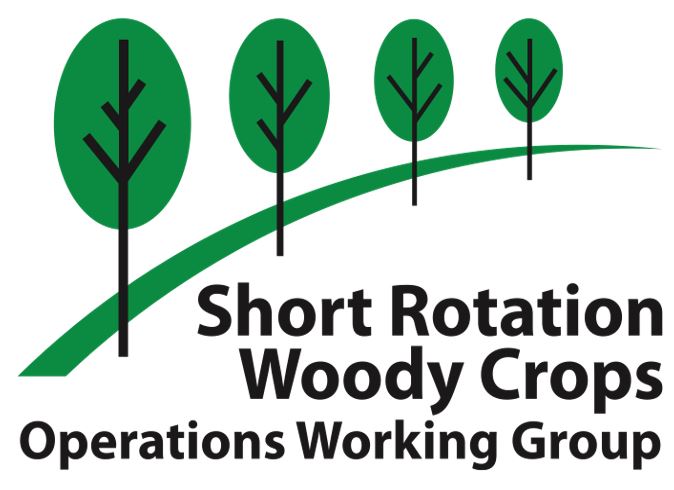Background

Short rotation woody crops (SRWC) are an environmentally acceptable and potentially economically efficient method of producing wood for fiber and fuel. As demand increases for hardwood fiber, new readily available sources are needed to reduce demands on upland and bottomland forests. SRWC plantations can reduce demands on national forests, improve local rural economic development, and ensure future wood supplies. The environmental benefits of woody crops when grown in a renewable fashion are also important. Woody crops can reduce the rate of atmospheric CO2 buildup by sequestering carbon and by substituting for fossil fuels. The combustion of woody crops can also reduce SO2 and NOx emissions relative to fossil fuels. At the local environmental level, woody crops can reduce soil erosion, filter soil leachates from water entering streams and ground water, and promote greater wildlife habitat and biodiversity.
With the advent of successfully developed genetically superior clones of woody crops interest has substantially increased in the entire scope of SRWC operations. At a recent mechanization conference hosted by the DOE and the USDA Forest Service, a number of impediments were underscored as deficiencies to the development of commercialized woody crops:
- the stalled development of practices, equipment, and implements to establish, maintain, and utilize large plantations (i.e., commercialization operations);
- the lack of consideration of the diversity of operations and machinery required by different feedstock producers;
- and the necessity of commercializing SRWC for differing end-users.
Successful commercialization of SRWC as either a source of fiber or as an energy feedstock material, depends on a diversity of practices and equipment for these highly specialized crops.
Mission and Objectives
In a mutually beneficial and collaborative fashion, the USDA Forest Service, DOE’s Oak Ridge National Laboratory (ORNL), and the Electric Power Research Institute (EPRI) have established a SRWC Operations Working Group to consider the efficient development of practices and equipment to culture, harvest and handle large-scale woody biomass plantations. The mission of the Working Group is to promote collaborative efforts in developing needed operations for SRWC plantations that comply with the principles of economic viability, ecological soundness, and social acceptance. To fulfill its mission, the Working Group has the following objectives:
- understand and communicate the SRWC operational needs for different end-users and end-products;
- promote the development of cost-effective and environmentally sound SRWC plantation operations and refinement of existing practices (equipment, systems, and technologies).
Scope
The Working Group will serve as a venue for information exchange and for the management, promotion, evaluation, and development of SRWC operations that are low-cost and environmentally acceptable. The Working Group will serve as a liaison among forest industries, equipment manufacturers, electric utilities, DOE, USDA Forest Service, International Energy Agency and researchers. The Working Group will also interface with researchers in plant development and propagation (e.g., nurseries) as well as end-product users and conversion technology developers. The Working Group will primarily be national in scope. It will focus on all operational aspects of growing and harvesting SRWC plantations including site preparation, planting, cultural management, harvesting and extraction, handling and processing, hauling, and plantation design) managed for tree stems 3-10 inches in diameter.
Activities
A primary purpose of the Working Group is to foster communication and enhance cooperation, identify issues and concerns (see annex), promote collaborative action and research, and facilitate funding support for equipment and systems development and demonstrations. Specific activities will include:
- Maintaining a mailing list
- Sponsoring a newsletter
- Serving as an information clearinghouse (database, internet home-page, etc.)
- Sponsoring workshops, conferences, and demonstrations
- Promoting and prioritizing collaborative research and development
- Establishing protocols for the evaluation, reporting, testing, and design of equipment and systems
- Assisting in research funding
Structure
The Working Group will be ad-hoc in structure and be open to all organizations and individuals with an interest in the commercialization of SRWC. The Working Group will be managed by a Steering Committee. The immediate responsibilities of the Steering Committee are to organize the Working Group, plan and execute an organizing conference, assess issues and needs, establish an information clearinghouse and network for exchange, and seek funding for Working Group activities. The Steering Committee members as well as specific functions will be re-assessed at annual meetings of the Working Group.
Annex Issues and Concerns
- Improving the cost-effectiveness of site preparation, planting, cultural, harvesting, processing, handling, and hauling operations
- identify high priority R&D needs (e.g., harvest efficiency, improved delimbing/debarking, wet ground operation, stump removal and use, multi- functional machines for
- combining operations, improved recovery of multiple products)
- identify appropriate development processes (e.g., incremental improvements to existing technologies; develop smaller-sized equipment; include users in equipment development; develop analytical framework for design; develop systems)
- Understanding the biological and cultural considerations in the design and configuration of harvesting and handling equipment
- species considerations (stem form, coppice habits)
- silvicultural and operational considerations (topography, scale of operation, contiguous block size, spacing and age, site accessibility, soil compaction, coppice/non-coppice regeneration, handling stumps and residues)
- Conducting economic, engineering, and environmental characterizations of multiple harvesting and handling systems (felling and bunching, pre-haul, comminution, handling, multi-product processing, in-field vs. mill processing, product contamination and effects on conversion process, etc.)
- Collecting information and developing a data base (operating parameters and costs) on currently available equipment systems; producing a set of design parameters to aid the development of specialized equipment
- Reducing site impacts through the development of equipment, operations, and systems that are environmentally and socially acceptable
- assess effects of soil compaction on biomass productivity and mitigation measures either through remediation or through equipment design
- evaluate quantitatively the tradeoffs between soil compaction and biomass productivity